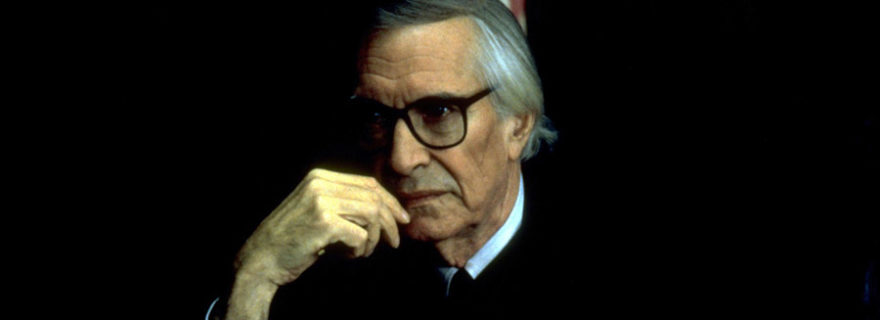We lost a pair of screen legends over the weekend, one famous for working in front of the camera and one behind. Oscar-winning actor Martin Landau passed away on Saturday. He was followed on Sunday by filmmaker George Romero, the man who revolutionized the horror genre.
Martin Landau
With over six decades in the business, Martin Landau was a true entertainment industry lifer. As a young man, he made dozens of TV appearances throughout the 1950s and ’60s with small parts in popular shows including ‘Bonanza’, ‘Maverick’, ‘Gunsmoke’ and ‘The Twilight Zone’. Alfred Hitchcock gave him a memorable role as a henchman in his classic thriller ‘North by Northwest‘, but Landau’s true breakout came back on TV, starring as one of the main leads in the smash hit ‘Mission: Impossible’. Unfortunately, his decision to leave the series after three seasons due to a contract dispute harmed his career for a number of years.
Landau famously turned down the role of Mr. Spock on ‘Star Trek’, a decision he claims he did not regret. Nonetheless, he wound up in sci-fi TV anyway in the 1970s, playing the lead in Gerry Anderson’s ‘Space: 1999‘. The corny show was popular with kids of the day, but only lasted two seasons, the second of which suffered from serious production and scripting problems that turned off many fans.
Follow the cancelation of that series, Landau kept working but was stuck for another decade doing bit parts on TV and in the occasional movie. Remarkably, his career renaissance began at age 60, when Francis Ford Coppola cast him as Jeff Bridges’ business partner in the bio-pic ‘Tucker: The Man and His Dream’. Although the movie wasn’t a box office hit, Landau’s performance was singled out for praise by critics and earned him an Oscar nomination for Best Supporting Actor.
Another Oscar nomination followed the next year for his work in Woody Allen’s ‘Crimes and Misdemeanors‘. He finally took home the trophy five years after that for playing Bela Lugosi in Tim Burton’s acclaimed ‘Ed Wood‘.
Sadly, Landau was unable to parlay these successes into long-term career growth. He never found another role quite as juicy as Lugosi, and returned to doing more bit parts in TV and largely unmemorable movies. (Perhaps the best of these was a small story arc as a doddering, out-of-touch movie producer in HBO’s ‘Entourage‘.) Nevertheless, he continued working steadily right up until the end, and has several projects in various states of completion at the time of his death.
Martin Landau died on Saturday from undisclosed health complications. He was 89-years-old.
George A. Romero
I talked about George Romero just this past Friday in our Roundtable post about movies of 1968. The director’s impact not just on horror filmmaking, but on modern pop culture in general, can hardly be measured. His shoestring-budget fright flick ‘Night of the Living Dead‘ gave birth to the zombie genre that has proved unkillable in movies, TV, books, comics, videogames and more for the past five decades.
Although the concept of the reanimated dead had of course appeared on screen before 1968 (at least as far back as 1932’s ‘White Zombie’), Romero created a whole new mythology for the monsters – depicting them as virtually unstoppable lumbering horrors that swarm victims and crave human flesh. His interpretation was compelling and terrifying enough to override some of the film’s amateurish production values and acting performances. Produced for peanuts, the movie grossed $30 million, a staggering amount for its day. It addition to Romero’s official sequels, it has spawned several remakes, unofficial quasi-sequels, and innumerable knockoffs. Without ‘Night of the Living Dead’, there would be no ‘Resident Evil’, or ‘World War Z’, or ‘The Walking Dead’.
Romero’s own ‘Dead’ pictures, especially 1978’s ‘Dawn of the Dead‘, stand apart from all the imitators by virtue of the filmmaker infusing them with satire and social commentary. He handles this more elegantly in some of the movies than others, but all share his unique voice. ‘Dawn of the Dead’, still made for a paltry $1.5 million, benefits from improved production values and a clearer vision, and was an even bigger hit than the original. In fact, it’s one of the most successful independent films of all time.
The director had less luck outside of zombie movies, but some of his efforts such as ‘The Crazies‘, ‘Martin’ and ‘Knightriders‘ were influential on later filmmakers.
Throughout most of his career, Romero maintained his independence from Hollywood, working outside the studio system with low budgets. However, after closing out the ‘Living Dead’ franchise (for a while) with 1985’s ‘Day of the Dead‘, he attempted to play ball with a major studio. His experience making two movies for Orion Pictures – 1988’s ‘Monkey Shines‘ and 1993’s ‘The Dark Half‘ – left him embittered with the industry. Both were also box office failures. In the wake of that, he returned to the independent scene.
Having increasing difficulty getting anything produced in his later career, Romero resurrected his signature franchise in the early 2000s with a new trilogy of films (‘Land of the Dead‘, ‘Diary of the Dead‘ and ‘Survival of the Dead‘) that were unfortunately less acclaimed or successful than the originals.
Just prior to his death, Arrow Video announced an upcoming Blu-ray box set called ‘George A. Romero: Between Night and Dawn‘ that will contain three of the director’s non-zombie pictures: ‘There’s Always Vanilla’ (1971), ‘Season of the Witch’ (1972) and ‘The Crazies’ (1973).
George Romero died of lung cancer on Sunday at the age of 77.
[Sources: The Hollywood Reporter and Los Angeles Times]






john barbarry
I loved Landau in Ed Wood which is also my favorite Burton film. He was good in Rounders, too.
Julian
Agreed. ‘Ed Wood’ is Burton’s masterpiece, and Landau is the highlight. ‘Karloffff?!’
Csm101
I think Creepshow is also worth mentioning as one of Romero’s best works outside of Night and Dawn. I’m looking forward to that Arrow box set.